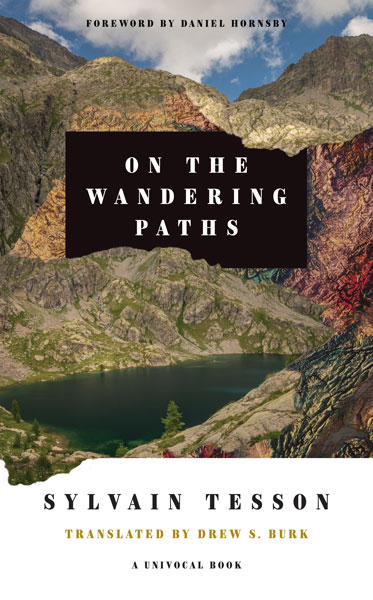“A path was a path was a path was a path. A path was a person and a path was a mind, walk, chop, walk, chop.” — Patricia Lockwood, No One is Talking About This
“We were seeking out the invisible paths.” — Sylvain Tesson, On the Wandering Paths
Every move we make is a move toward who we are becoming. Sometimes we need to stop to see how far we’ve gone. Sometimes we need to fall to see how high we are.

On the Wandering Paths (University of Minnesota Press, 2022) is the result of a free-climbing accident that put Sylvain Tesson in a coma and a hospital for four months. He promised himself that if he ever walked again, he would walk across France. The book is by turns an autobiographical travel journal and a philosophical critique of modern life. Originally published there to much acclaim, this new English version was translated by our friend Drew S. Burk, who also wrote the Afterword. He rightfully described the book to me as “a powerful and complex work.”
The walk is as transformative as it is a means of transport. “As soon as my eyes would open in the early morning light,” Tesson writes, “the fire deep inside was already stoking itself for the day’s movement. These were the moments I perhaps cherished the most in life: quick plunges into obsession.”
Tesson’s fall also left his grill in a permanent grimace, which elicits stares from young children and charity from old women. Seeking water and shelter as he can along the way, he picks up and drops walking companions as well. “The walker is not worthy of what he treads upon,” he tells the writer and explorer Cédric Gras, who joins the walk for a few fall days.
On the Wandering Paths plays well with other books. I think immediately of Rebecca Solnit’s Wanderlust: A History of Walking (Penguin, 2001) or Andy Merrifield’s The Wisdom of Donkeys (Bloomsbury, 2010), but I agree with Daniel Hornsby in his Foreword to this edition when he mentions Frédéric Gros’s A Philosophy of Walking (Verso, 2015) and Jenny Odell’s How to Do Nothing (Melville House, 2019) as companions to On the Wandering Paths in a world-rejecting syllabus.
In Wanderlust, Solnit writes,
Walking still covers the ground between cars and buildings and the short distances within the latter, but walking as a cultural activity, as a pleasure, as travel, as a way of getting around is fading, and with it goes an ancient and profound relationship between body, world, and imagination.
Tesson walks in this fading, old spirit of the act, lamenting the post-war urbanization of France and its reaching, stretching “tentacles of highway infrastructures,” single-family homes and billboards promising big-box commerce littering the landscape: “Awake from your sleep, dear countryside!” It only took 40 years for the country to be remodeled around the car. Expecting shepherds on foot, Tesson finds them with trucks and TVs in their cabins. “What’s important in life is to equip oneself with a good pair of blinders,” he writes.
Hornsby calls him “Thoreau in motion.” Tesson writes toward the end of his journey, “It was a voyage born from a fall. Some of the paths and routes had been sufficiently solitary and labyrinthian to suit my tastes.” He seems satisfied with the completion of the walk but also ready to apply the same resolve to what follows:
From now on, new invisible paths would open themselves up on the horizon: beyond simply glancing down at a map at 1:25,000 scale, my task would be to invent them. A strategy of withdrawal. Flights, retreats, gentle steps along the coast, long absences burdened with silence and fed on visions.
Before the first roads were paved, they were dirt paths worn by hooves and wooden wheels; before that, they were trade routes trampled by footfalls; and before that, the paths were invisible, simply the desire to find our way, to find ourselves.
The title of this post, “You are your path,” is the slogan of my favorite BMX company, Heresy BMX. Apologies to Alexis Desolneux.
I marshal the middle between Mathers and McLuhan.
Editor of Boogie Down Predictions (Strange Attractor, 2022), author of Escape Philosophy (punctum, 2022) and Dead Precedents (Repeater, 2019).
